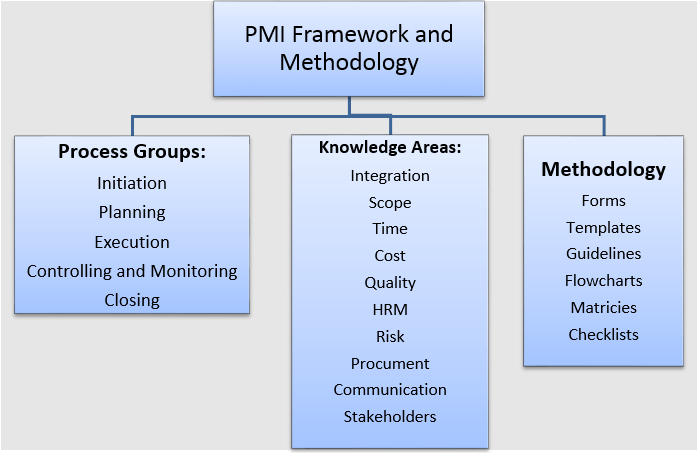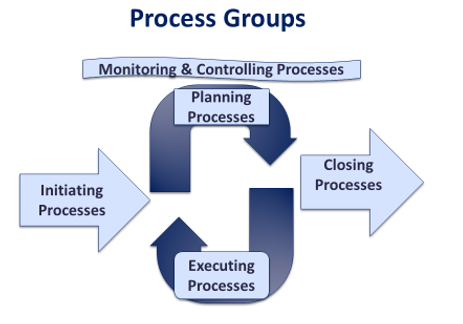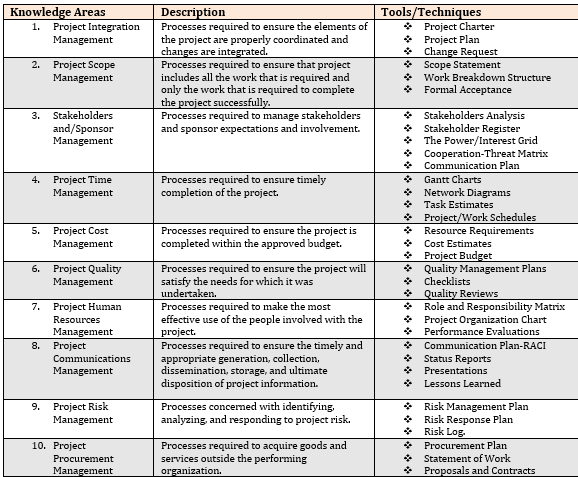2. Adopting the Project Management Framework
Learning Objectives
- Explain the phases in the Project Life Cycle.
- Examine the significant activities and implication to the path a project takes from initiation to closure.
- Define key elements of the project management framework.
- Outline project processes and knowledge areas and demonstrate how project activities are mapped to these processes for successful project management.
- Examine the effectiveness of project management methodology.
- Discuss how organizations benefit from adopting those processes oriented toward customer satisfaction.
The Project Life Cycle
The project manager and project team have one shared goal: to carry out the work of the project for the purpose of meeting the project’s objectives. Every project has a beginning, a middle period during which activities move the project toward completion, and an ending (either successful or unsuccessful). A standard project typically has the following four major phases (each with its own agenda of tasks and issues):
- Initiating
- Planning
- Executing/Monitoring & Controlling
- Closing
Taken together, these phases represent the path a project takes from the beginning to its end and are generally referred to as the project “life cycle.”

Concept Check
Should Project Management be a profession?
Many different professions contribute to the theory and practice of project management. Engineers and architects have been managing major projects since pre-history. Since approximately the 1960s, there have been efforts to professionalize the practice of project management as a specialization of its own. There are many active debates around this: Should project management be a profession in the same way as engineering, accounting, and medicine? These have professional associations that certify who is legally allowed to use the job title, and who can legally practice the profession. They also provide a level of assurance of quality and discipline members who behave inappropriately. Another ongoing debate is: How much industry knowledge is required of a seasoned project manager? How easily can a project manager from one industry, say, IT, transition to another industry such as public safety or law enforcement?
There are two major organizations with worldwide impact on the practice of project management: the Project Management Institute (PMI), with world headquarters in the United States, and the International Project Management Association (IPMA), with world headquarters in Switzerland. This textbook takes an approach that is closer to the PMI approach.
Project Management Institute Overview
Five volunteers founded the Project Management Institute (PMI) in 1969. Their initial goal was to establish an organization where members could share their experiences in project management and discuss issues. Today, PMI is a non-profit project management professional association and the most widely recognized organization in terms of promoting project management best practices. PMI was formed to serve the interests of the project management industry. The premise of PMI is that the tools and techniques of project management are common even among the widespread application of projects from the software to the construction industry. PMI first began offering the Project Management Professional (PMP) certification exam in 1984. As of 2020, there were over one million active PMP-certified professionals worldwide.
To help keep project management terms and concepts clear and consistent, PMI introduced – A Guide to the Project Management Body of Knowledge (PMBOK Guide) in 1987. The most current version updated in August 2021 is the seventh edition. At present, there are more than one million copies of the PMBOK Guide in circulation and PMI members can access it online.
What is Project Management?
PMI defines project management is the application of knowledge, skills, tools and techniques to project activities to meet project requirements.
PMI Project Framework and Methodology
The PMI project framework tells you what you have to do, to manage your projects from start to finish. It describes every step in the project life cycle in depth, so you know exactly which tasks to complete, when and how. The framework is made up of five (5) process groups and ten (10) knowledge areas.
Project management methodologies is a repetitive process which uses a set of forms, guidelines, templates and checklists and other tools that can be applied to specific projects or situations.

What are PMBOK Process Groups?
The PMBOK is a collection of processes and knowledge areas generally accepted as best practice within project management discipline it provides the fundamentals and common vocabulary within the project management profession and identifies “good practices” of project management to apply skills, tools and techniques and enhances the prospects of project success. PMBOK identifies five basic process groups:
- Initiating
- Planning
- Executing/Performing
- Monitoring and Controlling
- Closing

Project initiation processes define a new project or a new phase of an existing project. Once the initiation is done, processes required to establish the scope of the project and the course of action to execute and complete the project are determined. The execution processes deals with all processes required to complete the project within the established scope and project specification. Processes required to finalized and close the projects are grouped as closing processes. To control the performance of the project, monitoring and controlling processes track, review, evaluate, monitor, control and manage the project. Monitoring and controlling processes need to re-planned as needed in order to execute a project successfully.
What are PMBOK Knowledge Areas?
PMBOK is the fundamental knowledge you need for managing a project, categorized into 10 knowledge areas:
Managing integration: Projects have all types of activities going on and there is a need to keep the “whole” thing moving collectively – integrating all of the dynamics that take place.
Managing scope: Projects need to have a defined parameter or scope, and this must be broken down and managed through a work breakdown structure or WBS. Managing scope is about planning, definition, WBS creation, verification, and control.
Managing time/schedule: Projects have a definite beginning and a definite ending date. Therefore, there is a need to manage the budgeted time according to a project schedule. Managing time/schedule is about definition, sequencing, resource and duration estimating, schedule development, and schedule control.
Managing costs: Projects consume resources, and therefore, there is a need to manage the investment with the realization of creating value (i.e., the benefits derived exceed the amount spent). Managing costs is about resource planning, cost estimating, budgeting, and control.
Managing quality: Projects involve specific deliverables or work products. These deliverables need to meet project objectives and performance standards. Managing quality is about quality planning, quality assurance, and quality control.
Managing human resources: Projects consist of teams and you need to manage project team(s) during the life cycle of the project. Finding the right people, managing their outputs, and keeping them on schedule is a big part of managing a project. Managing human resources is about human resources planning, hiring, and developing and managing a project team.
Managing communication: Projects invariably touch lots of people, not just the end users (customers) who benefit directly from the project outcomes. This can include project participants, managers who oversee the project, and external stakeholders who have an interest in the success of the project. Managing communication is about communications planning, information distribution, performance reporting, and stakeholder management.
Managing risk: Projects are a discovery-driven process, often uncovering new customer needs and identifying critical issues not previously disclosed. Projects also encounter unexpected events, such as project team members resigning, budgeted resources suddenly changing, the organization becoming unstable, and newer technologies being introduced. There is a real need to properly identify various risks and manage these risks. Managing risk is about risk planning and identification, risk analysis (qualitative and quantitative), risk response (action) planning, and risk monitoring and control.
Managing procurement: Projects procure the services of outside vendors and contractors, including the purchase of equipment. There is a need to manage how vendors are selected and managed within the project life cycle. Managing procurement is about acquisition and contracting plans, sellers’ responses and selections, contract administration, and contract closure.
Managing stakeholders: Every project impacts people and organizations and is impacted by people and organizations. Identifying these stakeholders early, and as they arise and change throughout the project, is a key success factor. Managing stakeholders is about identifying stakeholders, their interest level, and their potential to influence the project; and managing and controlling the relationships and communications between stakeholders and the project.
This is the big framework for managing projects and if you want to be effective in managing projects, then you need to be effective in managing each of the 10 knowledge areas that make up PMBOK.
Introduction to the Project Management Knowledge Areas
As discussed above, projects are divided into components, and a project manager must be knowledgeable in each area. Each of these areas of knowledge will be explored in more depth in subsequent chapters. For now, let’s look at them in a little more detail to prepare you for the chapters that follow.

Key Takeaways
- A standard project typically has the following four major phases (each with its own agenda of tasks and issues): initiation, planning, executing incl. monitoring & controlling, and closure.
- The “Project Life Cycle” represents the path a project takes from the beginning to its end and it’s usually the four phases taken together.
- Though it would appear that the four phases should be handled one after another in a linear fashion, the reality of project work is seldom that tidy.
- Project management is the application of knowledge, skills, tools and techniques to interrelated project activities to meet project requirements. (PMBOK Guide 2021 – Seventh edition)
- The PMI project framework tells you what you have to do to manage your projects from start to finish. It describes every step in the project life cycle in depth, so you know exactly which tasks to complete, when and how. The framework is made up of process groups (5), knowledge areas (10) and numerous activities.
- Project management methodology is a repetitive process which uses a set of forms, guidelines, templates and checklist and other tools that can be applied to specific projects or situations.
- One key benefit of using project management framework is that it’s oriented towards customer satisfaction.
Attribution
This chapter is based on chapters 3 and 4 in Project Management CC BY 4.0 by Adrienne Watt — the chapters are adapted fromthe following texts:
- Project Management by Merrie Barron and Andrew Barron. © CC BY (Attribution).
- Project Management From Simple to Complex by Russel Darnall, John Preston, Eastern Michigan University. © Creative Commons Attribution 3.0 Licence.

